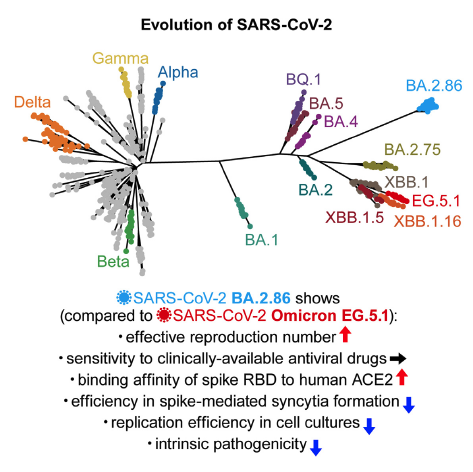Keypoints
・Around August 2023 the BA.2.86 variant of Omicron emerged, which differs significantly in sequence from the previously prevalent Omicron XBB strain. This study showed that the Omicron BA.2.86 strain exhibits significantly higher effective reproduction number (epidemic spreading ability) compared to existing epidemic strains such as Omicron EG.5.1.
・Antiviral drugs currently in use were effective against the Omicron BA.2.86 strain.
・Syncytium formation activity and proliferation ability in cells were reduced.
・The pathogenicity of the Omicron BA.2.86 strain in the hamster model was weaker compared to the Omicron BA.2 and EG.5.1 strains.
Research Summary
The Genotype to Phenotype Japan (G2P-Japan) research consortium, which includes researchers from Professor Shinya Tanaka’s lab at ICReDD and is led by Professor Kei Sato of the Department of Systems Virology at the Institute of Medical Science, The University of Tokyo, revealed the virological characteristics of the Omicron BA.2.86 strain, which emerged around August 2023. The Omicron BA.2.86 strain is phylogenetically distinct from the previously prevalent Omicron subtypes and accumulated over 30 mutations in its spike protein compared to its ancestral strain, Omicron BA.2. This study demonstrated that the Omicron BA.2.86 strain exhibits significantly higher effective reproduction number (epidemic spreading ability) than existing epidemic strains.
Additionally, detailed virological experiments on the Omicron BA.2.86 strain were conducted, showing a high sensitivity to commonly used antiviral drugs such as Remdesivir, Paxlovid, and Xocova. While the binding affinity to the infection receptor ACE2 was higher for the Omicron BA.2.86 strain than that of the EG.5.1 strain, its syncytium formation activity and proliferation ability in cells were lower than those of the EG.5.1 strain. Furthermore, the pathogenicity of the Omicron BA.2.86 strain in the hamster model was found to be weaker compared to the Omicron BA.2 and EG.5.1 strains.
These research findings were published online on January 26, 2024, in the journal Cell Host & Microbe.


